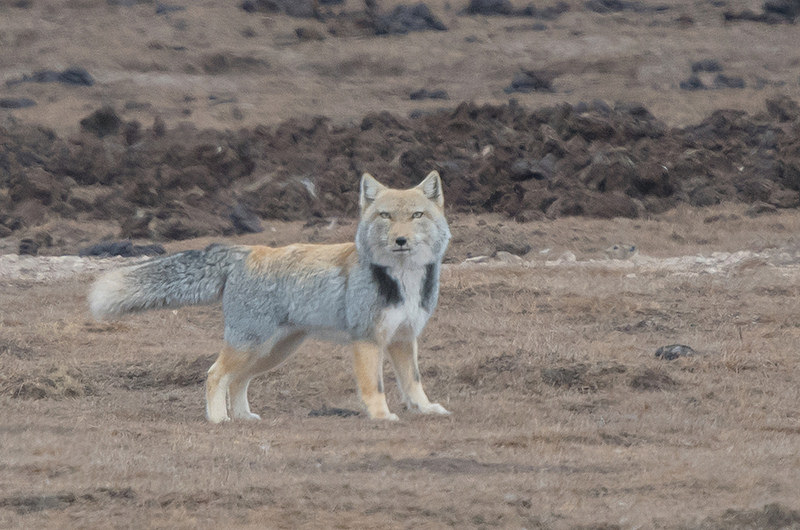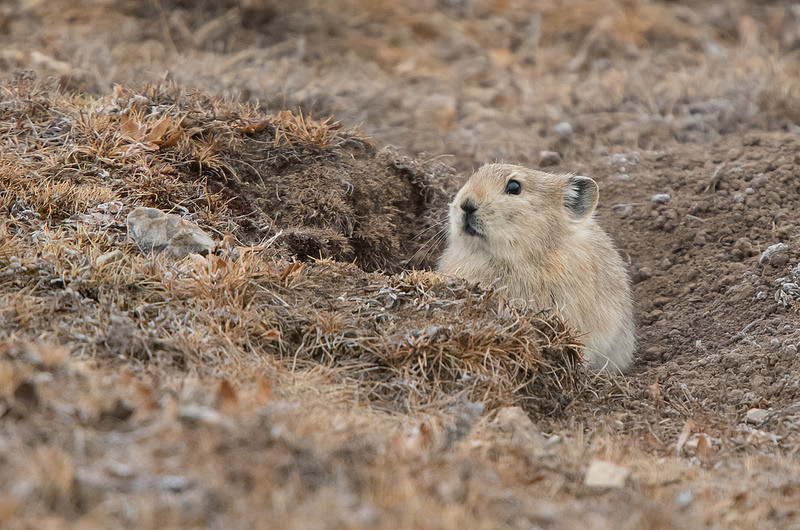
This beautifully ugly creature is also known as the Tibetan Sand Fox (Vulpes ferrilata). They live on the high Tibetan Plateau where they feed on Plateau Pikas, which are superabundant in the area. If you look just to the right of the fox you can see a Plateau Pika peeping out. I took this one near Roueregai in Sichuan, China at an elevation of about 3500m above sea level. We saw several, but they generally kept a safe distance from humans. This one is heavily cropped but I thought it was worth sharing.

What do you mean ugly? That is a very fine fox indeed.
It is almost too pretty to be a wild animal, I’d have one as a pet if they weren’t.
Fantastic picture of a fantastic animal.
I too think it is a fantastic looking animal, but it isn’t the stereotypical big-eyed beauty. I was being complimentary in my own way.
The Tibetan plateau is a fascinating place alright. There’s evidence that it was the ‘nursery’ (or ark even?) for much of the wildlife that populated the new cold regions during the ice age. A few million years ago before the ice ages began the plateau was considerably colder than it is today and of course the poles were warmer. The result was they’ve found the fossils ancestors of the arctic fox and the woolly rhino on the plateau. When the ice ages kicked in they spread from it, a ready made menagerie for the new cold lands. There was a special type of habitat during the ice ages – the mammoth steppe – a sort of combination tundra and steppe you don’t get during interglacials and it’s always been recognized that the closest approximation to it in the present day is on the Tibetan plateau. They’ve found remains of a Tibetan dung beetle in the UK from periods when the ice sheet would have been well advanced which is bloody extraordinary and shows what a wonderful, dynamic world we live in. I may well be wrong, but I think the rather dis-joined distribution of the ‘boring’ twite indicates it could have been another species which spread out of Tibet thanks to the changes the ice ages wrought. Bio-geography is as fascinating as any other aspect of natural history and it should get more attention. Very jealous of you Tim!!
Many thanks Les. I wish I had chatted with you before I visited, or better still, taken you with me. I’ve always been fascinated by biogeography and have pondered over the bizarre distribution of Twite many times (which incidentally looked the same, but sounded rather different). The Tibetan Plateau was an amazing place as it can only be reached by traversing high mountain passes, but when you arrive it is as flat as a pancake for mile after mile. More like a coastal floodplain really, but at an elevation of 3500m. Teeming with wildlife too. In addition to this we saw Wolves, Pallas’s Cats, Chinese Mountain Cats, Tibetan Gazelles, Golden Eagles, Hen Harriers, Saker Falcons, Merlins etc.
I only came across much of that info very recently certainly about the arctic fox and woolly rhino ancestor fossils on the plateau, and I read the excellent book about finches in the New Naturalist series a couple of weeks ago that gave an insight into the twite distribution. I’ll now look at it with additional respect when I finally see my first one, got an extra special buzz when I saw them on Winterwatch because of that snippet of new knowledge. I had read about the mammoth steppe and similarities to Tibetan grasslands before and the same with the dung beetle years ago, but the new info is really ‘complimenting it’. The plateau has had a surprisingly profound effect on current day biodiversity in the northern hemisphere, it gave us the arctic fox! Would make a fascinating documentary. Incidentally there’s a book called ‘The Monkey’s Voyage: How Improbable Journeys Shaped the History of Life’ by Alain de Queiroz that I haven’t read yet, but think will be brilliant for anyone interested in biogeography – it puts more emphasis on the role of animal movements via ocean dispersal including on rafts of vegetation.
Lovely comment your Tibetan bio-geography one, Les.
It really gets the psycho-geographical juices working. Thanks.
So that’s why this fox has that undone bow tie inter-glacial partying look.
‘Mammoth steppe’ – fabulous terminology, stepping back into a not so far away land-time capsule.
It’s a fine looking animal overall, but a very strange looking head. Vital for keeping down the pika no doubt. That’s one of the things I remember about the French Alps, the place looked like it was grazed to death by marmots.
What a handsome fox, with real attitude. It looks as if it could talk. Thanks for sharing a shot of this stunning creature.